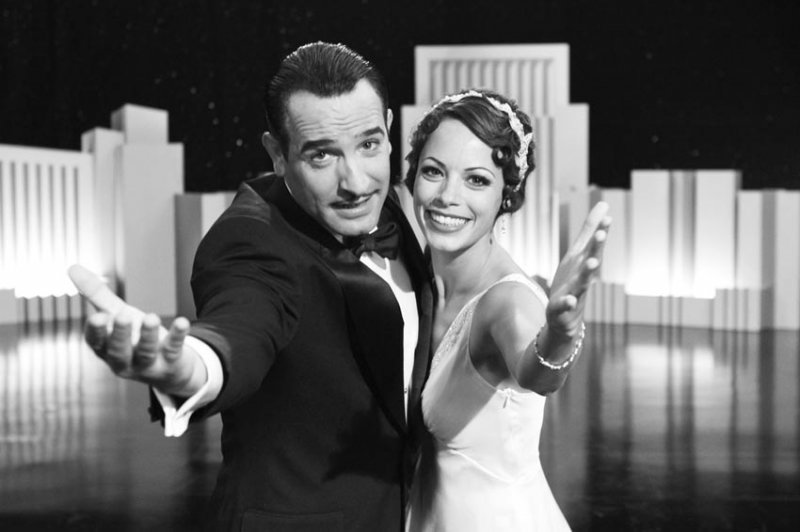It’s a weird thing to watch a silent film in 2011. You might get the urge to ask the movie theater crew to crank up the volume. Yet, French director Michel Hazanavicius’s The Artist has received much critical acclaim for its innovation and artistry. It received accolades for Best Picture and Best Director by the New York Film Critics Circle, took Best Actor (for Jean Dujardin’s performance) at the Cannes Film Festival, and received a whopping 10 Oscar nominations.
One lesson we as an audience or as filmmakers might glean from The Artist is not how to save money on sound, but rather how might other elements of film, besides dialogue, command our attention?
In a silent film, the mise-en-scène becomes especially important because that is the only way of communicating information to the audience. And some of the best screenshots, allow us to understand the conflict that ensues in the plot without having watched the film.
As Hazanavicius suggests from the quote below, the essential and yet very basic lesson from The Artist is to show, not tell.
[sws_blockquote_endquote align=”” cite=”” quotestyle=”style03″] You, as a director, you have to do your job, you have to show things, and you don’t have to ask the actors to do it, or the dialogue. For example, this character is very egocentric. So how can you show he’s egocentric? As a screenwriter I have to find a solution if I don’t want to ask the actor to act egocentric, because that means nothing. There’s one shot in the movie, he walks down the stairs and he stops just in front of the big painting of himself and he says “Hi.” Everybody loves it because he’s funny, but the real information you get is that this guy is crazy about himself. He has this painting in his own house! After a while you see this painting as his own story. At the very end of the movie, when he’s not able to see that a lady loves him because he’s too much in his own misery, you accept it because at the very beginning he has been exposed as egocentric. To me, the challenge of that is in the screenwriting. The director does what the screenwriter wrote, and in this case it’s the same person. I can change whatever I want. I didn’t ask the actors to act something they don’t have to. I do my job, and this is really what I learned. If you really do your job, you do the situation and the images that tell the story, the actors will be fabulous because you didn’t ask them to do your job. It’s something that helps very much. [/sws_blockquote_endquote]
Accordingly, if the jobs of the director and the screenwriter are done properly, then such visual language should emanate from the scenes in the script even before the actors step on set.
Watching silent films, we’re forced to pay more attention to actors’ facial expressions and body language.
How does his body language differ when he’s stuck at a lunch with an unflattering blind date compared to a lunch where he wants to spend just one last minute with her? How does she react when a mouse crawls across her bedroom carpet? Does she jump on the bed and hide in the corner or does she grab a shoe and chase the rodent like a seasoned hunter?
If the film is done right, we get the feeling we’re watching scenarios that actually develop character, rather than feeling like cousin Ray Ray bought a new camera and is simply filming people talking.
Despite the missing dialogue, a silent film isn’t all that silent. The score becomes an important device to set the mood and pace of the film. The music of The Artist sets the stage for an Old Hollywood era film. Ludovic Bource won a Golden Globe Award and is nominated for an Oscar for his original score The Artist. Part of the score also comes from Bernard Herrmann’s composition in Alfred Hitchcock’s Vertigo.
But often, films rely too heavily on dialogue as a clutch. We become bored with the visual and stop watching the movie and just listen while we check our smartphones.
The exercise of writing a draft of a script before adding dialogue may aid filmmakers and screenwriters in developing a visual story. It may even elevate the dialogue to only capture what is not being shown on screen, or even more interestingly to contradict what we see.
Of course, the best movies have great dialogue as well, but the details are laid out in the visual language of the script. You’ll find visual storytelling present in many of the Hollywood scripts uploaded online for educational and learning purposes and unsurprisingly missing from many other scripts that have been turned into films but are mysteriously AWOL from any library, book, or online collections.
So take what you can from this film. Hollywood is barely ready to greenlight a substantive black film, much less a substantive black film on mute. Literally making a silent film probably won’t do anything to bolster anyone’s career, but learning from one may be a start.











this movie is a piece of work. and u are ‘dead on balls right’ right abt showing and not telling. we see too many talking heads in movies these days – and maybe these people just noticed that it was getting worse.
Great film, couldn’t praise it enough!